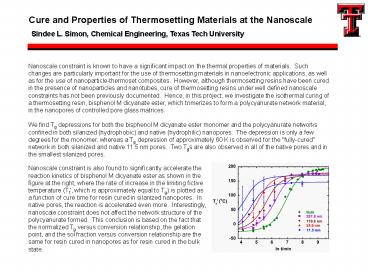Cure and Properties of Thermosetting Materials at the Nanoscale - PowerPoint PPT Presentation
1 / 1
Title:
Cure and Properties of Thermosetting Materials at the Nanoscale
Description:
Cure and Properties of Thermosetting Materials at the Nanoscale ... However, although thermosetting resins have been cured in the presence of ... – PowerPoint PPT presentation
Number of Views:37
Avg rating:3.0/5.0
Title: Cure and Properties of Thermosetting Materials at the Nanoscale
1
Cure and Properties of Thermosetting Materials at
the Nanoscale
Sindee L. Simon, Chemical Engineering, Texas Tech
University
- Nanoscale constraint is known to have a
significant impact on the thermal properties of
materials. Such changes are particularly
important for the use of thermosetting materials
in nanoelectronic applications, as well as for
the use of nanoparticle-thermoset composites.
However, although thermosetting resins have been
cured in the presence of nanoparticles and
nanotubes, cure of thermosetting resins under
well defined nanoscale constraints has not been
previously documented. Hence, in this project,
we investigate the isothermal curing of a
thermosetting resin, bisphenol M dicyanate ester,
which trimerizes to form a polycyanurate network
material, in the nanopores of controlled pore
glass matrices. - We find Tg depressions for both the bisphenol M
dicyanate ester monomer and the polycyanurate
networks confined in both silanized (hydrophobic)
and native (hydrophilic) nanopores. The
depression is only a few degrees for the monomer,
whereas a Tg depression of approximately 60 K is
observed for the "fully-cured" network in both
silanized and native 11.5 nm pores. Two Tgs are
also observed in all of the native pores and in
the smallest silanized pores.
Nanoscale constraint is also found to
significantly accelerate the reaction kinetics of
bisphenol M dicyanate ester as shown in the
figure at the right, where the rate of increase
in the limiting fictive temperature (Tf', which
is approximately equal to Tg) is plotted as a
function of cure time for resin cured in
silanized nanopores. In native pores, the
reaction is accelerated even more.
Interestingly, nanoscale constraint does not
affect the network structure of the polycyanurate
formed. This conclusion is based on the fact
that the normalized Tg versus conversion
relationship, the gelation point, and the sol
fraction versus conversion relationship are the
same for resin cured in nanopores as for resin
cured in the bulk state.































